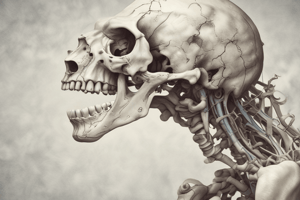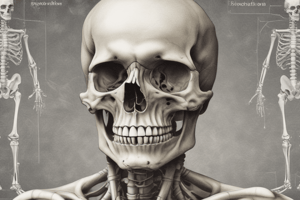Podcast
Questions and Answers
What is the primary defect associated with Osteogenesis Imperfecta?
What is the primary defect associated with Osteogenesis Imperfecta?
- Defect in type II collagen synthesis.
- Defective middle 1/3 of face.
- Inactivity of osteoclasts.
- Defect in type I collagen synthesis. (correct)
Which condition is characterized by solid, dense but brittle bones?
Which condition is characterized by solid, dense but brittle bones?
- Osteopetrosis (correct)
- Fibrous Dysplasia
- Osteogenesis Imperfecta
- Achondroplasia
What type of malocclusion is commonly associated with Achondroplasia?
What type of malocclusion is commonly associated with Achondroplasia?
- Class II malocclusion
- Class III malocclusion (correct)
- Class I malocclusion
- No malocclusion
Which condition involves a painless bony swelling and can affect normal function of mastication?
Which condition involves a painless bony swelling and can affect normal function of mastication?
What is a common dental feature in patients with Osteogenesis Imperfecta?
What is a common dental feature in patients with Osteogenesis Imperfecta?
What characterizes Cemento-osseous Dysplasia in middle-aged African American women?
What characterizes Cemento-osseous Dysplasia in middle-aged African American women?
What dental issue is associated with Cleidocranial Dysplasia?
What dental issue is associated with Cleidocranial Dysplasia?
Which genetic bone disorder is associated with the SH3BP2 gene mutation?
Which genetic bone disorder is associated with the SH3BP2 gene mutation?
What often complicates radiographic examination in Osteopetrosis?
What often complicates radiographic examination in Osteopetrosis?
What is a defining characteristic of Fibrous Dysplasia?
What is a defining characteristic of Fibrous Dysplasia?
Flashcards
Osteogenesis Imperfecta
Osteogenesis Imperfecta
A genetic disorder characterized by brittle bones due to a defect in type I collagen synthesis, often resulting in thin long bones that fracture easily.
Cleidocranial Dysplasia
Cleidocranial Dysplasia
A rare genetic disease primarily affecting the skull and clavicles, causing abnormally small or missing clavicles and delayed closure of skull sutures.
Osteopetrosis
Osteopetrosis
A hereditary or sporadic disorder characterized by excessive bone density, making bones strong but brittle and prone to fractures.
Fibrous Dysplasia
Fibrous Dysplasia
Signup and view all the flashcards
Cemento-osseous Dysplasia
Cemento-osseous Dysplasia
Signup and view all the flashcards
Achondroplasia
Achondroplasia
Signup and view all the flashcards
Cherubism
Cherubism
Signup and view all the flashcards
Osteogenesis Imperfecta
Osteogenesis Imperfecta
Signup and view all the flashcards
Osteopetrosis
Osteopetrosis
Signup and view all the flashcards
Fibrous Dysplasia
Fibrous Dysplasia
Signup and view all the flashcards
Study Notes
Bone Diseases Classification
- Bone diseases categorized into genetic/inherited, fibro-osseous lesions, metabolic/endocrine disorders, and other lesions.
Achondroplasia
- Most common genetic skeletal disorder.
- Patients have a defect in osteochondral ossification in long bones, resulting in short limbs.
- Flat bones are typically normal in size.
- Characterized by a defect in the middle third of the face and a class 3 malocclusion.
Osteogenesis Imperfecta
- Characterized by excessive bone fragility due to a defect in type 1 collagen synthesis.
- Leads to generalized osteoporosis.
- Bones are thin and susceptible to fracture.
- Patients often require wheelchairs due to the severity of the fractures.
- Patients may have blue sclera (thin sclera), hearing loss, and/or joint hypermobility.
Osteopetrosis
- Marble bone disease (Albers-Schönberg disease).
- Inactivity of osteoclasts leads to excessive bone formation.
- Bone marrow spaces are replaced by bone.
- Results in anemia due to reduced bone marrow space.
- Patients may experience hepatosplenomegaly (enlarged liver and spleen).
- Bones are dense and brittle, increasing fracture risk.
Cleidocranial Dysplasia
- Characterized by delayed closure of cranial sutures and fontanelles, resulting in a flattening of the skull.
- Missing or incomplete clavicles.
- May have unerupted or multiple teeth, and supernumerary teeth.
- Can lead to class 3 malocclusion.
Fibrous Dysplasia
- Defect in genes controlling osteoblast growth and differentiation.
- Can be monostotic (affecting one bone) or polyostotic (affecting multiple bones).
- Common sites include the maxilla and mandible.
- May present as a painless, well-defined bony swelling.
- Can result in facial asymmetry.
Cemento-Osseous Dysplasia
- Group of bone disorders involving cementoblasts.
- Periapical cemento-osseous dysplasia presents as calcified lesions near the teeth.
- Focal cemento-osseous dysplasia involves a single or handful of areas.
- Florid cemento-osseous dysplasia is more extensive often affecting 3 areas or more.
- Radiolucent or radiopaque lesions.
Cherubism
- Hereditary condition.
- Mutation in SH3BP2 gene.
- Bilateral and symmetrical bony expansion of the maxilla and mandible.
- Appearance of a "moon face".
- Premature loss of primary teeth, and malformed permanent teeth.
Studying That Suits You
Use AI to generate personalized quizzes and flashcards to suit your learning preferences.




